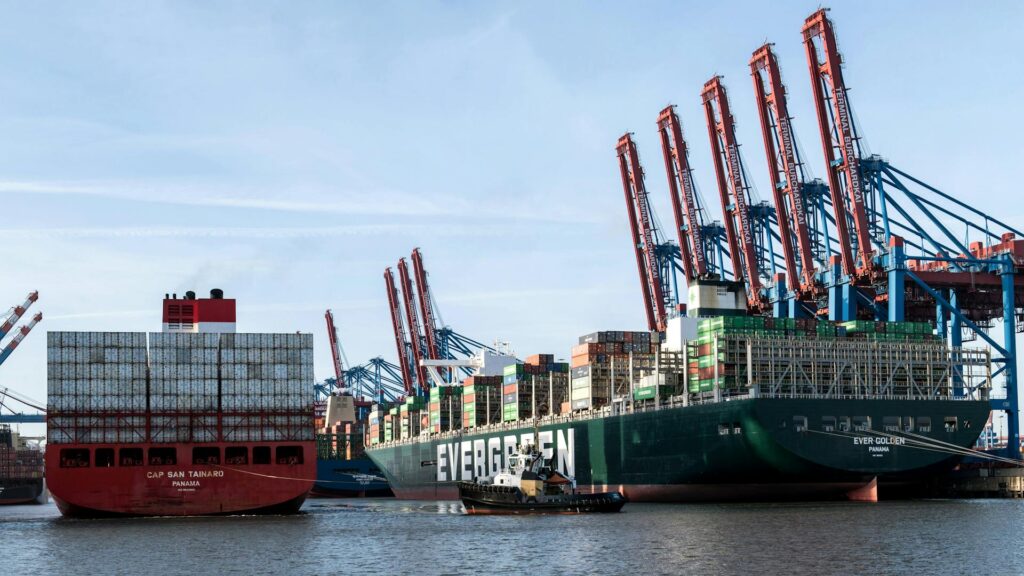
In the complex landscape of international trade today, sea freight serves as a crucial link connecting economic exchanges among countries. In the sea freight operations related to Lebanon, the phenomenon of “Lebanese sea freight grey clearance” has become increasingly prominent and has drawn the attention of numerous trade practitioners. Next, we will delve deep into this phenomenon, starting from the import demands of the Lebanese market, exploring the roots of why so many sea freight double – clearance operations in Lebanon involve grey clearance, and uncovering the potential risks hidden within.
The Panorama of Import Demands in the Lebanese Market Against the Background of Lebanese Sea Freight Grey Clearance
(I) Energy Supplies: The Cornerstone of Development
Lebanon has limited energy reserves, and its domestic production struggles to meet the growing demands of the economy and people’s livelihood. Against the backdrop of the frequent occurrence of the “Lebanese sea freight grey clearance” phenomenon, petroleum and its derivative products, as the main imported energy sources, have their transportation and clearance situations under close scrutiny. Gasoline and diesel fuel power the transportation system, being essential for both public transportation and freight vehicles. Meanwhile, some fuel – powered power generation facilities keep the demand for petroleum products high.
In addition, with the increasing demand for clean energy, the import volume of liquefied natural gas (LNG) is gradually rising, which is widely used in industrial production and residential heating. During the sea – borne import process of these energy supplies, issues related to “Lebanese sea freight grey clearance” also occur from time to time.
(II) Construction and Infrastructure Materials: Support for Reconstruction and Development
After years of turmoil and reconstruction, Lebanon has an urgent need for construction and infrastructure materials. Construction materials such as steel, cement, wood, building ceramics, as well as infrastructure construction materials like wires, cables, and pipeline materials, continuously enter the Lebanese market via sea freight. However, during this process, the phenomenon of “Lebanese sea freight grey clearance” has brought many uncertainties to the smooth import of these materials.
Steel, as a key support for building structures, cement for preparing concrete to ensure the stability of buildings, wood for decoration and light – structure construction, and building ceramics for enhancing aesthetics and functionality, all may be involved in “Lebanese sea freight grey clearance” during their import transportation, affecting Lebanon’s reconstruction and development process.
(III) Daily Consumer Goods: A Reflection of People’s Livelihood Demands
1. Food Sector: Balancing Diversity and Necessity
Although Lebanon has a certain agricultural foundation, population growth and changes in the consumption structure have led to a continuous increase in the demand for imported food. The demand for staple grains remains stable, and the import volume of processed foods and specialty foods is also on the rise, such as European chocolates, cheeses, and Asian specialty seasonings. Fresh fruits and vegetables during non – local production seasons rely even more on imports to meet nutritional needs. In the sea – borne import of food, the issue of “Lebanese sea freight grey clearance” may affect the stability of food supply and quality, which is closely related to people’s daily lives.
2. Textiles and Apparel: The Pursuit of Fashion and Practicality
The Lebanese consumers’ pursuit of fashion and quality has driven the import of textiles and apparel. From high – end fashion brands to daily basic – style items, as well as home textile products such as bedding and curtains, they are all on the import list, meeting the different needs of residents’ lives and social and cultural activities. However, the phenomenon of “Lebanese sea freight grey clearance” may bring legal risks and cargo loss risks to the import trade in this area, affecting market supply.
3. Electronic Products: Facilitators of Technological Life
The development of technology has driven the growing demand for electronic products among the Lebanese people. Mobile devices such as smartphones, tablets, and laptops, as well as home appliances such as televisions, refrigerators, and air conditioners have become popular imports, meeting the needs of entertainment, work, and improving the quality of life. However, the existence of “Lebanese sea freight grey clearance” makes the import transportation of electronic products face many unstable factors, such as cargo damage and delays, affecting consumers’ usage experience and the normal operation of the market.
Analysis of the Causes of the Lebanese Sea Freight Grey Clearance Phenomenon
(I) Customs Policies: A Maze of Complexity and Variability
Lebanese customs policies are complex, and they are adjusted frequently due to the political environment at different times. Import tax rates, declaration requirements, and inspection and quarantine standards are numerous and lack transparency. Specific products may suddenly face additional tariffs or special inspection procedures, and importers find it difficult to obtain accurate information and make adjustments in a timely manner. The customs has strict requirements for details such as the origin and composition of goods, and the slightest discrepancy in the declaration may hinder customs clearance.
This complex policy environment makes compliant customs clearance extremely difficult, thus giving rise to the phenomenon of “Lebanese sea freight grey clearance.” Some importers, in an attempt to avoid cumbersome procedures, reluctantly choose “Lebanese sea freight grey clearance” in the hope of transporting goods to Lebanon more conveniently.
(II) Tariffs and Economic Pressures: A Cost – Driven Choice
To protect domestic industries and increase fiscal revenue, Lebanon imposes high tariffs on most imported goods, especially high rates on industrial manufactured products, significantly increasing import costs. When the economy faces challenges such as currency devaluation and insufficient foreign exchange reserves, importers are under great pressure. To reduce costs and obtain profits, some importers, driven by interests, choose “Lebanese sea freight grey clearance” to evade high tariffs. For example, for electronic products with high tariffs, the selling price after normal customs clearance may lack competitiveness, prompting importers to seek “Lebanese sea freight grey clearance” methods in an attempt to reduce costs while maintaining market share.
(III) The Logistics Industry: A Vortex of Unregulated Competition
The Lebanese sea freight logistics market is highly competitive, and some freight forwarders adopt unethical means to secure business. They promise importers low – cost and fast double – clearance services, which are actually achieved through “Lebanese sea freight grey clearance.” Some freight forwarders use improper relationships with customs officials or reduce customs clearance costs by misdeclaring product names and undervaluing goods. Some importers, due to a lack of understanding of industry regulations and a pursuit of low costs, are lured into choosing “Lebanese sea freight grey clearance,” further fueling the spread of this unhealthy phenomenon and disrupting the normal order of sea freight customs clearance.
(IV) The Trade Environment: Risk Preference Brought About by Instability
The long – term political instability in Lebanon has an impact on the trade environment. Political unrest leads to chaos in customs management, and policy implementation lacks consistency. The alternation of different political forces may cause significant adjustments to customs policies, making it difficult for importers to adapt to stable customs clearance rules. Economic instability causes fluctuations in market demand. Under operational pressure, importers tend to choose the seemingly cost – reducing and fast – shipping “Lebanese sea freight grey clearance” method to maintain their business. Although they are aware of the risks, they take the plunge driven by economic interests. This choice of “Lebanese sea freight grey clearance” in an unstable trade environment fills the entire sea – borne import chain with risks.
Warnings of Risks Hidden in Lebanese Sea Freight Grey Clearance
(I) Legal and Compliance: The Sword of Damocles Hanging High
1. Huge Fines and Cargo Confiscation: A Severe Economic Blow
Once the “Lebanese sea freight grey clearance” behavior is detected by the customs, importers will face severe sanctions. The customs usually imposes huge fines on the contraband goods, which may be several times the value of the goods, and in serious cases, the goods will be directly confiscated. Importers not only lose the cost of the goods but also have to bear the previous transportation, warehousing, and other expenses. For example, if an importer deliberately undervalues the goods to evade tariffs, in addition to recovering the tariffs, the customs may impose a fine several times the amount of the payable tariffs, dealing a heavy blow to the importer’s cash flow and putting the enterprise in a serious economic predicament.
2. Legal Litigation and Reputation Damage: The Collapse of Business Reputation
In addition to economic penalties, importers may face legal litigation, which consumes a great deal of time and energy and seriously damages their business reputation. In international trade, reputation is the lifeline of an enterprise. Once the issue of “Lebanese sea freight grey clearance” is exposed, partners will question the importer’s integrity, reduce or terminate cooperation, affecting the enterprise’s future business expansion and market share, dealing a fatal blow to the long – term development of the enterprise.
(II) Cargo Risks: Uncertain Clouds During Transportation
1. Cargo Detention and Damage: The Depreciation of Value
“Lebanese sea freight grey clearance” does not follow regular customs clearance procedures, greatly increasing the possibility of cargo detention at customs or during transshipment. Prolonged detention may cause time – sensitive goods to miss the best sales opportunities, leading to depreciation or even a complete loss of value, such as seasonal clothing and fresh food. During non – regular operations, due to the lack of professional warehousing and handling conditions, goods are likely to be squeezed and collided during transshipment and stacking, resulting in damaged packaging and goods, causing direct economic losses to importers and greatly reducing the value of the goods.
2. Cargo Loss: An Unbearable Burden
The “Lebanese sea freight grey clearance” relies on unregulated channels and operations, significantly increasing the risk of cargo loss. During illegal transshipment or unregulated warehousing, goods may be lost due to poor management or theft. Once the goods are lost, it is difficult for importers to obtain effective compensation, which may lead to financial difficulties and put the enterprise in an operational crisis.
(III) Supply Chain and Market: The Crisis of Chain Reactions
1. Supply Chain Disruption: The Disintegration of Operational Order
Once the “Lebanese sea freight grey clearance” behavior is exposed, the entire supply chain will be implicated. Freight forwarders may be punished for violations and unable to continue providing services, disrupting the transportation of subsequent goods. Business partners such as suppliers and distributors will also be affected, triggering a chain reaction and undermining the stability of the supply chain. For example, suppliers may stop supplying due to risks, and distributors may cancel orders due to the inability to receive goods on time, affecting the normal operation of the enterprise and disrupting the orderly operation of the entire supply chain.
2. Market Fluctuations and Customer Loss: The Shaking of Market Position
The uncertainty of “Lebanese sea freight grey clearance” makes it difficult for importers to ensure the stable supply and timely delivery of goods, leading to market price fluctuations and weakening competitiveness. Customers may turn to other reliable suppliers due to repeated experiences of delayed delivery or quality problems (caused by “Lebanese sea freight grey clearance” – damaged goods), resulting in customer loss, which poses a long – term threat to the importer’s foothold and development in the Lebanese market, putting the enterprise’s position in the market at risk.
In conclusion, the phenomenon of “Lebanese sea freight grey clearance” has complex causes and numerous risks. Importers, logistics practitioners, and relevant regulatory authorities need to deeply understand its seriousness and jointly create a healthy and compliant sea freight trading environment to ensure the sustainable development of Lebanese sea freight operations and avoid the various negative effects brought about by “Lebanese sea freight grey clearance.”





